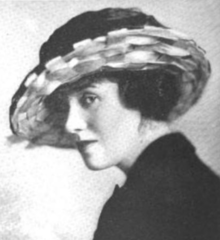Clara Moores
Clara Moores | |
|---|---|
 Clara Moores, from a 1920 publication; she is wearing a hat made from wood shavings, as publicity for a show called Shavings | |
| Born | Clara Louise Munchhoff July 27, 1896 Omaha, Nebraska |
| Died | January 21, 1986 (aged 89) Seattle, Washington |
| Other names | Clare Moores, Clara Payson |
| Occupation | Actress |
| Spouse | William Farquhar Payson |
Clara Moores Payson (July 27, 1896[1] – January 21, 1986), born Clara Munchhoff, was an American stage actress.
Early life
Clara Louise Munchhoff was born in Omaha, Nebraska in 1898, the daughter of Joseph W. Munchhoff and Mate (or May Etta) Cannon Munchhoff. Her father owned a traveling carnival.[2] Her mother was active in the suffrage movement and her (step) grandfather, Frank E. Moores,[3] was a controversial Mayor of Omaha.[4] She adopted the surname of her stepfather, railwayman Harry E. Moores, after her mother remarried in 1909.[5] She was raised in Seattle,[6] and graduated from Broadway High School[7] and attended the University of Washington.[8]
Career
Moores acted on the stage,[9] beginning in college, and later mainly in Boston[10] and on Broadway, with stage credits including roles in Madame X, Under Cover,[8] A Cure for Curables (1918),[11] His Majesty Bunker Bean, Dangerous Years,[12] Lilies of the Field, Shavings (1920), Pot Luck (1921),[13] Common Clay, Cobra (1924) and The Circle.[14][15][16]
Moores was considered a stylish beauty in her time.[17] The costumes she wore on stage were described in detail.[18] As publicity for Shavings, she was photographed in hats made from wood shavings.[19] In 1920, she wrote a beauty advice column on attractive arms, for newspaper syndication.[20][21]
During World War II, Moores (by then named Payson) organized vaudeville-style entertainments for enlisted men stationed in the Seattle area.[22]
Personal life
Moores became the second wife of writer, editor, and publisher William Farquhar Payson in 1927.[14][23] Her husband died in 1939;[24] she died in Seattle in 1986, aged 89 years.
References
- ^ Some sources give 1898 as Clara Moores' birth year, but 1896 is the year given on her grave marker, via Find a Grave, and in the US Social Security Death Index, via Ancestry. It also matches her appearance as a 3-year-old in the 1900 US Federal Census, via Ancestry.
- ^ "Flashes". The McCook Daily Gazette. 1931-06-06. p. 1. Retrieved 2022-08-11 – via Newspapers.com.
- ^ "Stumped Her Way to Stage Success". The Philadelphia Inquirer. 1920-12-26. p. 52. Retrieved 2022-08-11 – via Newspapers.com.
- ^ "The Mayor of Omaha: The Supreme court rules ..." (PDF). New York Times. 24 September 1898. Retrieved 12 August 2022.
- ^ "Short Stories of Transportation". Railway and Marine News. 18: 23. July 1920.
- ^ "Chestnut St. Opera House". The Philadelphia Inquirer. 1919-04-20. p. 44. Retrieved 2022-08-11 – via Newspapers.com.
- ^ "Clara Moores". The Brooklyn Daily Eagle. 1924-06-01. p. 65. Retrieved 2022-08-12 – via Newspapers.com.
- ^ a b "Summer-time Amusements". The Boston Globe. 1914-08-09. p. 53. Retrieved 2022-08-11 – via Newspapers.com.
- ^ Stevens, Ashton (1923). Actorviews: Intimate Portraits. Covici-McGee Company. pp. 153–157.
- ^ "Played One Role Nearly Two Years". The Boston Globe. 1922-01-22. p. 58. Retrieved 2022-08-11 – via Newspapers.com.
- ^ "Chestnut St. Opera House". The Philadelphia Inquirer. 1919-04-20. p. 44. Retrieved 2022-08-11 – via Newspapers.com.
- ^ "Shubert Theatre". The Chat. 1919-05-31. p. 67. Retrieved 2022-08-11 – via Newspapers.com.
- ^ "'Pot Luck' at the St James". The Boston Globe. 1922-02-21. p. 19. Retrieved 2022-08-11 – via Newspapers.com.
- ^ a b "W. F. Payson Marries; Publisher Weds Clara Moores Actress, in Municipal Chapel". The New York Times. 1927-08-28. ISSN 0362-4331. Retrieved 2022-08-11.
- ^ "In the Spotlight". Theatre Magazine. 27: 284. May 1918.
- ^ "Dramatic Club to Attend John Drew Performance January 16 in a Body". Logansport Pharos-Tribune. 1923-01-04. p. 5. Retrieved 2022-08-11 – via Newspapers.com.
- ^ The Captain Kid Book and Judge Annual. Leslie-Judge Company. 1920. p. 25.
- ^ "Sports Clothes and Summer Frocks in Spring Plays". Dry Goods Economist. 72: 129. March 23, 1918.
- ^ "Wooden Hat's Latest Millinery Fad; Idea's Derived from Shavings on Floor". The Journal and Tribune. 1920-04-17. p. 10. Retrieved 2022-08-11 – via Newspapers.com.
- ^ Moores, Clara (1920-06-28). "Arms and the Man". The Ogden Standard-Examiner. p. 5. Retrieved 2022-08-11 – via Newspapers.com.
- ^ Moores, Clara (1920-06-26). "Arms and the Man (2)". The Missoulian. p. 5. Retrieved 2022-08-11 – via Newspapers.com.
- ^ "Mrs. Brown to be speaker". The Seattle Star. 1942-01-27. p. 7. Retrieved 2022-08-12 – via Newspapers.com.
- ^ "Star Weds". Shamokin News-Dispatch. 1927-09-01. p. 1. Retrieved 2022-08-11 – via Newspapers.com.
- ^ "W.F. Payson Dead; Author, Publisher; Ex-Managing Editor of Vogue and Founder of Firm of Own Name Succumbs at 63". The New York Times. 1939-04-16. ISSN 0362-4331. Retrieved 2022-08-12.